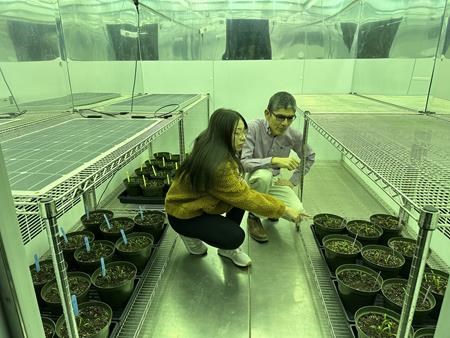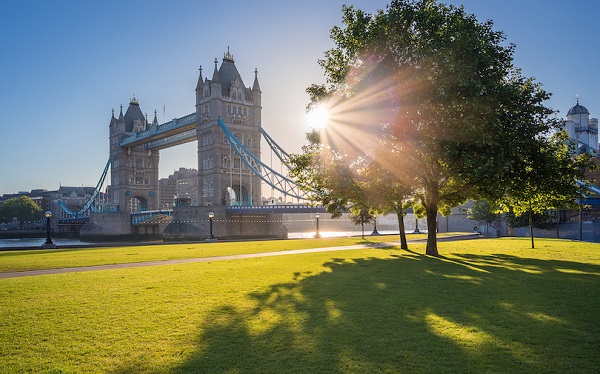Alberta
‘More connected’: Researchers looking at growing food under solar panels

EDMONTON — Lawns, backyards and roofs could be used to produce both solar power and fresh vegetables, University of Alberta researchers say.
Guillermo Hernandez, a soil scientist, and Camila Quiroz, a research intern from Peru, are looking into growing crops under solar panels to improve the use of space in cities and farms.
“We know how to generate electricity from sunlight. We also know how to grow crops,” says Hernandez. “But the question is, can we do the two things in the same space?”
Crop harvesting under solar panels is called agrivoltaics, a relatively new concept to improve land-use efficiency by producing energy and food in the same spot.
In a 25-day experiment, Hernandez and Quiroz grew batches of spinach under three systems — thick solar panels, thin solar panels and without solar panels.
The researchers used simulated sunlight in a small room at the university during the Alberta winter.
Quiroz, who is studying energy engineering in Peru, says there weren’t any significant differences in taste or nutrition between the spinach grown under solar panels and the batch grown under simulated sunlight.
“I ate some of the solar panel-grown spinach,” Quiroz says. “They were sweet. The taste was perfect.”
However, the solar panel-grown plants were smaller than the batch grown without the panels.
Quiroz says a “little more time” under the panel would help them mature better.
The researchers are conducting a lab analysis to determine the exact nutritional composition of the three batches, and will be publishing the results in the coming weeks.
Quiroz says agrivoltaics is about more than just optimizing land area.
Solar panels create a microclimate underneath them, shielding plants from direct sunlight and fostering the right temperatures. Greens, berries and broccoli are among the foods that grow well under solar panels.
Quiroz says solar panels could also contribute to higher crop production for certain foods and improve water efficiency.
“Another benefit is the increase the solar energy generation,” Quiroz says.
An International Energy Agency report this year said investors are increasingly gravitating towards solar-powered projects, outpacing the spending on fossil fuel projects for the first time.
Hernandez says even though the initial cost of installing solar panels could be high, agrivoltaics has the potential to become a part of the urban landscape in Canada.
“The connection with food is missing in some urban areas.”
He says agrivoltaic farming would teach people to grow fresh produce while harnessing solar energy on balconies, backyards and smaller areas.
“People will be able to witness growing their own food, and they will feel more connected to where their food is coming from.”
Some provincial governments have been giving rebates and grants to households and institutions for installing solar panels.
Other countries, including South Korea and France, are also experimenting with agrivoltaics.
Hernandez says the next step is to secure funding for research on other vegetables and explore how solar panels work outdoors and at differing heights and angles.
He is also working on a guide for agrivoltaic farming, which would include a list of crops that can be grown under solar panels.
This report by The Canadian Press was first published May 27, 2023.
—-
This story was produced with the financial assistance of the Meta and Canadian Press News Fellowship.
Ritika Dubey, The Canadian Press
Alberta
Alberta judge sides with LGBT activists, allows ‘gender transitions’ for kids to continue

From LifeSiteNews
‘I think the court was in error,’ Alberta Premier Danielle Smith has said. ‘There will be irreparable harm to children who get sterilized.’
LGBT activists have won an injunction that prevents the Alberta government from restricting “gender transitions” for children.
On June 27, Alberta King’s Court Justice Allison Kuntz granted a temporary injunction against legislation that prohibited minors under the age of 16 from undergoing irreversible sex-change surgeries or taking puberty blockers.
“The evidence shows that singling out health care for gender diverse youth and making it subject to government control will cause irreparable harm to gender diverse youth by reinforcing the discrimination and prejudice that they are already subjected to,” Kuntz claimed in her judgment.
Kuntz further said that the legislation poses serious Charter issues which need to be worked through in court before the legislation could be enforced. Court dates for the arguments have yet to be set.
READ: Support for traditional family values surges in Alberta
Alberta’s new legislation, which was passed in December, amends the Health Act to “prohibit regulated health professionals from performing sex reassignment surgeries on minors.”
The legislation would also ban the “use of puberty blockers and hormone therapies for the treatment of gender dysphoria or gender incongruence” to kids 15 years of age and under “except for those who have already commenced treatment and would allow for minors aged 16 and 17 to choose to commence puberty blockers and hormone therapies for gender reassignment and affirmation purposes with parental, physician and psychologist approval.”
Just days after the legislation was passed, an LGBT activist group called Egale Canada, along with many other LGBT organizations, filed an injunction to block the bill.
In her ruling, Kuntz argued that Alberta’s legislation “will signal that there is something wrong with or suspect about having a gender identity that is different than the sex you were assigned at birth.”
She further claimed that preventing minors from making life-altering decisions could inflict emotional damage.
However, the province of Alberta argued that these damages are speculative and the process of gender-transitioning children is not supported by scientific evidence.
“I think the court was in error,” Alberta Premier Danielle Smith said on her Saturday radio show. “That’s part of the reason why we’re taking it to court. The court had said there will be irreparable harm if the law goes ahead. I feel the reverse. I feel there will be irreparable harm to children who get sterilized at the age of 10 years old – and so we want those kids to have their day in court.”
READ: Canadian doctors claim ‘Charter right’ to mutilate gender-confused children in Alberta
Overwhelming evidence shows that persons who undergo so-called “gender transitioning” procedures are more likely to commit suicide than those who are not given such irreversible surgeries. In addition to catering to a false reality that one’s sex can be changed, trans surgeries and drugs have been linked to permanent physical and psychological damage, including cardiovascular diseases, loss of bone density, cancer, strokes and blood clots, and infertility.
Meanwhile, a recent study on the side effects of “sex change” surgeries discovered that 81 percent of those who have undergone them in the past five years reported experiencing pain simply from normal movements in the weeks and months that followed, among many other negative side effects.
Alberta
Alberta Independence Seekers Take First Step: Citizen Initiative Application Approved, Notice of Initiative Petition Issued

Alberta’s Chief Electoral Officer, Gordon McClure, has issued a Notice of Initiative Petition.
This confirms a Citizen Initiative application has been received and the Chief Electoral Officer has determined the requirements of section 2(3) of the Citizen Initiative Act have been met.
Approved Initiative Petition Information
The approved citizen initiative application is for a policy proposal with the following proposed question:
Do you agree that Alberta should remain in Canada?
The Notice of Initiative Petition, application, and statement provided by the proponent are available on Elections Alberta’s website on the Current Initiatives Petition page.
As the application was received and approved prior to coming into force of Bill 54: Election Statutes Amendment Act, the Citizen Initiative process will follow requirements set out in the Citizen Initiative Act as of June 30, 2025.
Next Steps
- The proponent must appoint a chief financial officer within 30 days (by July 30, 2025).
- Once the 30-day publication period is complete and a chief financial officer has been appointed, Elections Alberta will:
- issue the citizen initiative petition,
- publish a notice on the Current Initiatives Petition page of our website indicating the petition has been issued, specifying the signing period dates, and the number of signatures required for a successful petition, and
- issue the citizen initiative petition signature sheets and witness affidavits. Signatures collected on other forms will not be accepted.
More information on the process, the status of the citizen initiative petition, financing rules, third party advertising rules, and frequently asked questions may be found on the Elections Alberta website.
Elections Alberta is an independent, non-partisan office of the Legislative Assembly of Alberta responsible for administering provincial elections, by-elections, and referendums.
-

 Automotive2 days ago
Automotive2 days agoElectric vehicle sales are falling hard in BC, and it is time to recognize reality.
-

 Energy2 days ago
Energy2 days agoChina undermining American energy independence, report says
-

 Business2 days ago
Business2 days agoTrump on Canada tariff deadline: ‘We can do whatever we want’
-

 Business2 days ago
Business2 days agoEurope backs off greenwashing rules — Canada should take note
-

 Automotive2 days ago
Automotive2 days agoPower Struggle: Electric vehicles and reality
-

 Alberta13 hours ago
Alberta13 hours agoAlberta judge sides with LGBT activists, allows ‘gender transitions’ for kids to continue
-

 Business20 hours ago
Business20 hours agoCanada Caves: Carney ditches digital services tax after criticism from Trump
-

 Crime3 hours ago
Crime3 hours agoNational Health Care Fraud Takedown Results in 324 Defendants Charged in Connection with Over $14.6 Billion in Alleged Fraud






